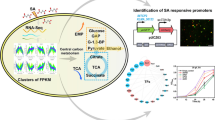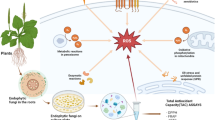Abstract
Inhibition of spore germination offers an attractive and effective target for controlling fungal species involved in food spoilage. Mushroom alcohol (1-octen-3-ol) functions as a natural self-inhibitor of spore germination for many fungi and, therefore, provides a useful tool for probing the molecular events controlling the early stages of fungal growth. In Penicillium spp., the R and S enantiomers of 1-octen-3-ol delayed spore germination and sporulation in four species of Penicillium involved in soils of fruit and grains, but to different degrees. Because of its well-annotated genome, we used Penicillium chrysogenum to perform a comprehensive comparative transcriptomic analysis of cultures treated with the two enantiomers. Altogether, about 80% of the high-quality reads could be mapped to 11,396 genes in the reference genome. The top three active pathways were metabolic (978 transcripts), biosynthesis of secondary metabolites (420 transcripts), and microbial metabolism in diverse environments (318 transcripts). When compared to the control, treatment with (R)-(-)-1-octen-3-ol affected the transcription levels of 91 genes, while (S)-(+)-1-octen-3-ol affected only 41 genes. Most of the affected transcripts were annotated and predicted to be involved in transport, establishment of localization, and transmembrane transport. Alternative splicing and SNPs’ analyses indicated that, compared to the control, the R enantiomer had greater effects on the gene expression pattern of Penicillium chrysogenum than the S enantiomer. A qRT-PCR analysis of 28 randomly selected differentially expressed genes confirmed the transcriptome data. The transcriptomic data have been deposited in NCBI SRA under the accession number SRX1065226.










Similar content being viewed by others
References
Ballester AR, Marcet Houben M, Levin E, Sela N, Selma Lázaro C, Carmona L, Wisniewski M, Droby S, González Candelas L, Gabaldón T (2015) Genome, transcriptome, and functional analyses of Penicillium expansum provide new insights into secondary metabolism and pathogenicity. Mol Plant Microbe Interact 28(3):232–248
Bennett JW, Klich M (2003) Mycotoxins. Clin Microbiol Rev 16:497–516
Berendsen RL, Kalkhove SI, Lugones LG, Baars JJ, Wösten HA, Bakker PA (2013) Effects of the mushroom-volatile 1-octen-3-ol on dry bubble disease. Appl Microbiol Biotechnol 97(12):5535–5543
Blankenship SM, Dole JM (2003) 1-Methylcyclopropene: a review. Postharvest Biol Technol 28(1):1–25
Bohbot JD, Dickens JC (2009) Characterization of an enantioselective odorant receptor in the yellow fever mosquito Aedes aegypti. PLoS One 4(9):e7032
Chang PK, Hua SST, Sarreal SBL, Li RW (2015) Suppression of aflatoxin biosynthesis in Aspergillus flavus by 2-phenylethanol is associated with stimulated growth and decreased degradation of branched-chain amino acids. Toxins 7(10):3887–3902
Chitarra GS, Abee T, Rombouts FM, Dijksterhuis J (2005) 1-Octen-3-ol inhibits conidia germination of Penicillium paneum despite of mild effects on membrane permeability, respiration, intracellular pH, and changes the protein composition. FEMS Microbiol Ecol 54(1):67–75
Chitarra GS, Abee T, Rombouts FM, Posthumus MA, Dijksterhuis J (2004) Germination of Penicillium paneum conidia is regulated by 1-octen-3-ol, a volatile self-inhibitor. Appl Environ Microbiol 70(5):2823–2829
Cilek JE, Hallmon CF, Johnson R (2011) Semi-field comparison of the BG Lure, nonanal, and 1-octen-3-ol to attract adult mosquitoes in northwestern Florida. J Am Mosquito Control Assoc 27(4):393–397
Combet E, Eastwood DC, Burton KS, Henderson J (2006) Eight-carbon volatiles in mushrooms and fungi: Properties, analysis, and biosynthesis. Mycoscience 47:317–326
Cook JI, Majeed S, Ignell R, Pickett JA, Birkett MA, Logan JG (2011) Enantiomeric selectivity in behavioural and electrophysiological responses of Aedes aegypti and Culex quinquefasciatus mosquitoes. Bull Entomol Res 101(5):541–550
Cruz AF, Hamel C, Yang C, Matsubara T, Gan Y, Singh AK, Kuwada K, Ishii T (2012) Phytochemicals to suppress Fusarium head blight in wheat-chickpea rotation. Phytochemistry 78:72–80
De Lucca AJ, Carter Wientjes CH, Boué S, Bhatnagar D (2011) Volatile trans-2-hexenal, a soybean aldehyde, inhibits Aspergillus flavus growth and aflatoxin production in corn. J Food Sci 76(6):M381–M386
Dijkstra FY, Wiken TO (1976) Studies on mushroom flavours. 1. Organoleptic significance of constituents of the cultivated mushroom, Agaricus bisporus. Zeitschrift fur Lebensmittel-Untersuchung und-Forschung 160(3):255-62
Fischer G, Dott W (2003) Relevance of airborne fungi and their secondary metabolites for environmental, occupational and indoor hygiene. Arch Microbiol 179:75–82
Garcia D, Ramos AJ, Sanchis V, Marín S (2009) Predicting mycotoxins in foods: a review. Food Microbiol 26(8):757–769
Grant AJ, Dickens JC (2011) Functional characterization of the octenol receptor neuron on the maxillary palps of the yellow fever mosquito, Aedes aegypti. PLoS One 6(6):e21785
Harrison MA (1988) Presence and stability of patulin in apple products: a review. J Food Saf 9(3):147–153
Herrero Garcia E, Garzia A, Cordobés S, Espeso EA, Ugalde U (2011) 8-Carbon oxylipins inhibit germination and growth, and stimulate aerial conidiation in Aspergillus nidulans. Fungal Biol 115(4):393–400
Houbraken J, Samson RA (2011) Phylogeny of Penicillium and the segregation of Trichocomaceae into three families. Stud Mycol 70:1–51
Hung R, Lee S, Bennett JW (2015) Fungal volatile organic compounds and their role in ecosystems. Appl Microbiol Biotechnol 99(8):3395–3405
Inamdar AA, Hossain MM, Bernstein AI, Miller GW, Richardson JR, Bennett JW (2013) Fungal-derived semiochemical 1-octen-3-ol disrupts dopamine packaging and causes neurodegeneration. Proc Natl Acad Sci 110(48):19561–19566
Inamdar AA, Moore JC, Cohen RI, Bennett JW (2012) A model to evaluate the cytotoxicity of the fungal volatile organic compound 1-octen-3-ol in human embryonic stem cells. Mycopathologia 173(1):13–20
Korpi A, Järnberg J, Pasanen A (2009) Microbial volatile organic compounds. Crit Rev Toxicol 39:139–193
Luntz AM (2003) Arthropod semiochemicals: mosquitoes, midges and sealice. Biochem Soc Trans 31(1):128–133
Marcet Houben M, Ballester AR, de la Fuente B, Harries E, Marcos JF, González Candelas L, Gabaldón T (2012) Genome sequence of the necrotrophic fungus Penicillium digitatum, the main postharvest pathogen of citrus. BMC Genom 13(1):1
McMahon C, Guerin PM, Syed Z (2001) 1-octen-3-ol isolated from bont ticks attracts Amblyomma variegatum. J Chem Ecol 27(3):471–486
Mendgen K, Deising H (1993) Infection structures of fungal plant pathogens—a cytological and physiological evaluation. New Phytol 124(2):193–213
Miyamoto K, Murakami T, Kakumyan P, Keller NP, Matsui K (2014) Formation of 1-octen-3-ol from Aspergillus flavus conidia is accelerated after disruption of cells independently of Ppo oxygenases, and is not a main cause of inhibition of germination. Peer J 2:e395
Nemcovic M, Jakubikova L, Viden I, Farkas V (2008) Induction of conidiation by endogenous volatile compounds in Trichoderma spp. FEMS Microbiol Lett 284(2):231–236
Neri F, Mari M, Brigati S (2006) Control of Penicillium expansum by plant volatile compounds. Plant Pathol 55(1):100–105
Neri F, Mari M, Menniti A, Brigati S (2006) Activity of trans-2-hexenal against Penicillium expansum in ‘Conference’ pears. J Appl Microbiol 100(6):1186–1193
Noble R, Dobrovin Pennington A, Hobbs PJ, Pederby J, Rodger A (2009) Volatile C8 compounds and pseudomonads influence primordium formation of Agaricus bisporus. Mycologia 101(5):583–591
Okull DO, Beelman RB, Gourama H (2003) Antifungal activity of 10-oxo-trans-8-decenoic acid and 1-octen-3-ol against Penicillium expansum in potato dextrose agar medium. J Food Prot 66(8):1503–1505
Pasanen P, Korpi A, Kalliokoski P, Pasanen A (1997) Growth and volatile metabolite production of Aspergillus versicolor in house dust. Environ Int 162:263–272
Peng Q, Yuan Y, Gao M, Chen X, Liu B, Liu P, Wu Y, Wu D (2014) Genomic characteristics and comparative genomics analysis of Penicillium chrysogenum KF-25. BMC Genom 15(1):1
Pitt JI, Hocking AD, Diane A (2009) Fungi and food spoilage. Springer, Berlin
Ramoni R, Vincent F, Grolli S, Conti V, Malosse C, Boyer FD, Nagnan Le Meillour P, Spinelli S, Cambillau C, Tegoni M (2001) The insect attractant 1-octen-3-ol is the natural ligand of bovine odorant-binding protein. J Biol Chem 276(10):7150–7155
Rosenberger D (1990) Blue mold. Compend Apple Pear Dis 1:54–55
Rosenberger DA (1997) Recent research and changing options for controlling postharvest decays of apples. In: Proc. Harvesting, Handling, and Storage Workshop. Northeast Reg. Agric. Eng. Serv. Publ. NRAES-112. Cornell University, Ithaca, NY
Syed Z, Leal WS (2007) Maxillary palps are broad spectrum odorant detectors in Culex quinquefasciatus. Chem Senses 32:727–738
Thakeow P, Angeli S, Weissbecker B, Schutz S (2008) Antennal and behavioral responses of Cis boleti to fungal odor of Trametes gibbosa. Chem Senses 33(4):379–387
Trapnell C, Pachter L, Salzberg SL (2009) TopHat: discovering splice junctions with RNA-Seq. Bioinformatics 25(9):1105–1111
Trapnell C, Roberts A, Goff L, Pertea G, Kim D, Kelley DR, Pimentel H, Salzberg SL, Rinn JL, Pachter L (2012) Differential gene and transcript expression analysis of RNA-seq experiments with TopHat and Cufflinks. Nat Protoc 7(3):562–578
Tressl R, Bahri D, Engel K (1982) Formation of eight-carbon and ten-carbon components in mushrooms (Agaricus campestris). J Agric Food Chem 30:89–93
Van den Berg MA, Albang R, Albermann K, Badger JH, Daran JM, Driessen AJ, Garcia-Estrada C, Fedorova ND, Harris DM, Heijne WH et al (2008) Genome sequencing and analysis of the filamentous fungus Penicillium chrysogenum. Nat Biotechnol 26(10):1161–1168
Viehweg S, Schmitt R, Schmidtlorenz W (1989) Microbial spoilage of refrigerated fresh broilers.VII. Production of off odors from poultry skin by bacterial isolates. Lebensmittel-Wissenschaft und-Technologie 22:356–367
WHO (1990) Patulin. WHO Food Addit Ser 26:143–165
Wurzenberger M, Grosch W (1984) The formation of 1-octen-3-ol from the 10-hydroperoxide isomer of linoleic acid by a hydroperoxide lyase in mushrooms (Psalliota bispora). Biochimica et Biophysica Acta 794(1):25–30
Yang F, Zhang Y, Huang Q, Yin G, Pennerman KK, Yu J, Liu Z, Li D, Guo A (2015) Analysis of key genes of jasmonic acid mediated signal pathway for defense against insect damages by comparative transcriptome sequencing. Sci Rep 5:16500
Yin G, Padhi S, Lee S, Hung R, Zhao G, Bennett JW (2015) Effects of three volatile oxylipins on colony development in two species of fungi and on Drosophila larval metamorphosis. Curr Microbiol 71(3):347–356
Yung PY, Grasso LL, Mohidin AF, Acerbi E, Hinks J, Seviour T, Marsili E, Lauro FM (2016) Global transcriptomic responses of Escherichia coli K-12 to volatile organic compounds. Sci Rep 6:19899
Zawirska Wojtasiak R (2004) Optical purity of (R)-(-)-1-octen-3-ol in the aroma of various species of edible mushrooms. Food Chem 86(1):113–118
Acknowledgements
This work was primarily funded by the Special Fund for Agro-scientific Research in the Public Interest of the People’s Republic of China (Grant No. 201403075) and partially funded by the USDA-ARS Cooperative Agreement (Grant No. 2-47012). The funders played no role in experimental design, execution, data analysis, or decision to publish. Use of a company or product name by the U.S. Department of Agriculture does not imply approval or recommendation of the product to the exclusion of others that may also be suitable.
Author information
Authors and Affiliations
Corresponding authors
Additional information
Publisher's Note
Springer Nature remains neutral with regard to jurisdictional claims in published maps and institutional affiliations.
Electronic supplementary material
Below is the link to the electronic supplementary material.
Rights and permissions
About this article
Cite this article
Yin, G., Zhang, Y., Fu, M. et al. Influence of R and S enantiomers of 1-octen-3-ol on gene expression of Penicillium chrysogenum. J Ind Microbiol Biotechnol 46, 977–991 (2019). https://doi.org/10.1007/s10295-019-02168-4
Received:
Accepted:
Published:
Issue Date:
DOI: https://doi.org/10.1007/s10295-019-02168-4




